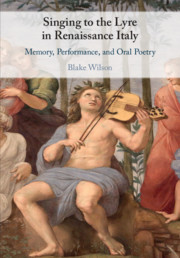Book contents
- Singing to the Lyre in Renaissance Italy
- Singing to the Lyre in Renaissance Italy
- Copyright page
- Contents
- Figures
- Tables
- Acknowledgments
- Abbreviations
- Introduction
- Part I The Canterino Tradition
- Part II Cantare ad Lyram: The Humanist Tradition
- 4 Florence: From Canterino to Cantare ad Lyram
- Excursus 2 Filippino Lippi’s Portrait of a Canterino
- 5 Cantare ad Lyram and Humanist Education
- 6 Cantare ad Lyram in the Courts
- 7 Rome: Cantare ad Lyram at the Summit
- Epilogue The Sixteenth Century
- Bibliography
- Index
4 - Florence: From Canterino to Cantare ad Lyram
from Part II - Cantare ad Lyram: The Humanist Tradition
Published online by Cambridge University Press: 31 October 2019
- Singing to the Lyre in Renaissance Italy
- Singing to the Lyre in Renaissance Italy
- Copyright page
- Contents
- Figures
- Tables
- Acknowledgments
- Abbreviations
- Introduction
- Part I The Canterino Tradition
- Part II Cantare ad Lyram: The Humanist Tradition
- 4 Florence: From Canterino to Cantare ad Lyram
- Excursus 2 Filippino Lippi’s Portrait of a Canterino
- 5 Cantare ad Lyram and Humanist Education
- 6 Cantare ad Lyram in the Courts
- 7 Rome: Cantare ad Lyram at the Summit
- Epilogue The Sixteenth Century
- Bibliography
- Index
Summary
As Charles Dempsey has argued, humanist culture often came about not through the revival of ancient models, but through the recasting of contemporary vernacular culture in light of ancient models. A central thesis of this book is that the ubiquitous humanist practice of solo singing to the lyre took shape principally in Florence, in the circles of Marsilio Ficino and Lorenzo de’ Medici/Angelo Poliziano, through adaptation of certain aspects of traditional canterino practice. This chapter sets forth what we know about the cantare ad lyram activity in these circles, establishes its clear relationship to civic practices, and argues for its integral role in both the Neoplatonic philosophy of Ficino and the vernacular poetics of Lorenzo and Poliziano. This leads to new perspectives on both Ficino’s “Orphic singing to the lyre” and Lorenzo’s lifelong involvement with singing to the lyre, both of which are typically regarded as idiosyncratic and tangential to their serious intellectual pursuits. This chapter also provides the occasion for considering the extraordinary figure of Baccio Ugolini, one of the great improvvisatori of his day, and a reassessment of Poliziano’s Fabula d’Orfeo in which Baccio sang the title role in 1480.
Keywords
- Type
- Chapter
- Information
- Singing to the Lyre in Renaissance ItalyMemory, Performance, and Oral Poetry, pp. 181 - 235Publisher: Cambridge University PressPrint publication year: 2019

